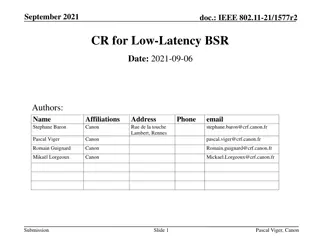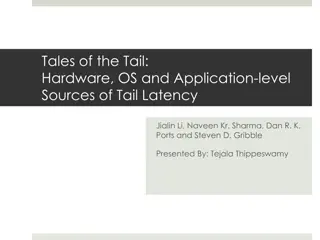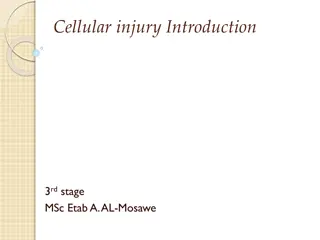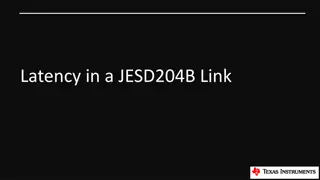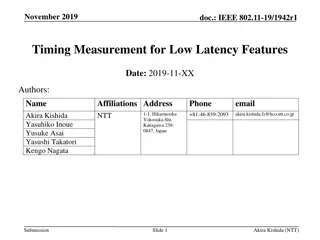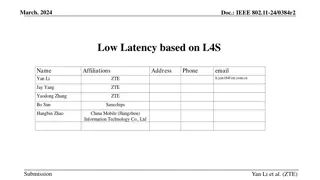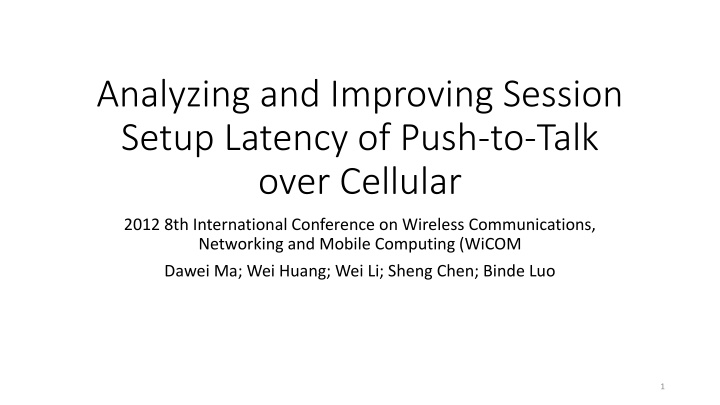
Analyzing and Improving Session Setup Latency for Push-to-Talk Over Cellular Networks
Explore the challenges and solutions for reducing session setup latency in Push-to-Talk over Cellular (PoC) communications at the 2012 WiCOM conference. Learn about the factors affecting latency, such as SIP messaging and wireless network delays, and methods to optimize latency through compressed signaling messages. Find out how error retransfers impact latency and strategies for minimizing delays in setting up PoC sessions.
Download Presentation

Please find below an Image/Link to download the presentation.
The content on the website is provided AS IS for your information and personal use only. It may not be sold, licensed, or shared on other websites without obtaining consent from the author. If you encounter any issues during the download, it is possible that the publisher has removed the file from their server.
You are allowed to download the files provided on this website for personal or commercial use, subject to the condition that they are used lawfully. All files are the property of their respective owners.
The content on the website is provided AS IS for your information and personal use only. It may not be sold, licensed, or shared on other websites without obtaining consent from the author.
E N D
Presentation Transcript
Analyzing and Improving Session Setup Latency of Push-to-Talk over Cellular 2012 8th International Conference on Wireless Communications, Networking and Mobile Computing (WiCOM Dawei Ma; Wei Huang; Wei Li; Sheng Chen; Binde Luo 1
Session Session setup setup latency(delay) latency(delay) Users of SIP-based PoC usually should wait a period of time between initiating a session to setting up one end-to-end connection due to the interchange of signaling messages and much longer transmission delay of wireless network. It is approximately a period of time over 6 7 seconds, or even up to more than 10 seconds.[1] 2
Session setup latency(delay) Session setup latency(delay) Three main sections in session setup latency of PoC: 1. Setting up the data channels over the radio link 2. The transfer of SIP messages over the established radio link 3. Transport in core of the mobile communication network and the processing of the message Session setup latency may be reduced if we transmit the compressed SIP signaling messages instead of the standard SIP signaling messages.[2] 3
Session setup latency(delay) Session setup latency(delay) Tr(1): the timer of first transfer, usually is a approximate value of Round Trip Time(RTT) which is 500ms in default [3] Tr(i): the timer of ith Tr(i)=2i 1 Tr(1) 4
Session setup latency(delay) Session setup latency(delay) Usually the transfer time of SIP messages includes the retransfer time because of the error occurring. We assume following conditions: 1. The error of signaling message transferring only results in re-transferring instead of replying. 2. It is linear correlation between the frame error ratio and message error ratio. There message consists of frames. 3. The wireless condition is based on the TD-SCDMA mobile communication network. Then the average transfer time of one SIP message is Ttransim. 5
Session setup latency(delay) Session setup latency(delay) ??? Tr(i) Ttransim= T + ?=1 T = N(???????? +??? 2) ????? P = ???????? ?????? X FER Tr(i) = T + Tr(i) The smaller the Mmessage is, the shorter the Ttransim is. We can reduce the transfer delay if we can cut down the length of SIP messages. 6
A New Method of SIP A New Method of SIP Compression Compression- -IDCM IDCM SIP signaling is consists of 44 characters and can be classified as two part, one part is instructions ( INVITE , BYE , etc.) and another part is user's data. An improved dictionary-based compression method (IDCM) of SIP compression to reduce the setup latency that using a new dictionary table with expanded elements for more possible transferred messages. 7
A New Method of SIP Compression A New Method of SIP Compression- -IDCM IDCM Make a dictionary table to put in all the characters of SIP messages. The dictionary table includes 44 characters of SIP signaling. Meanwhile some frequently used short terms and expressions are also included in this dictionary table. Every data put in the table is called an element. One element is expressed by a 10-bit number. So we set the size of the dictionary table to 1024(210=1024). 8
A New Method of SIP Compression A New Method of SIP Compression- -IDCM IDCM 9
Analysis (compare IDCM with LZSS) Analysis (compare IDCM with LZSS) Compare the compression ratio of the proposed IDCM with that of LZSS using a typical segment of SIP signaling INVITE & BYE . 10
Transfer Transfer Delay Delay Session setup latency vs. the amount of SIP messages Session setup latency vs. FER 11
Performance estimation on the prototype of Performance estimation on the prototype of POC system based on TD POC system based on TD- -SCDMA network SCDMA network 12
Performance estimation on the prototype of Performance estimation on the prototype of POC system based on TD POC system based on TD- -SCDMA network SCDMA network Tested the session setup latency for 100 times: 13
Conclusion Conclusion Session setup latency of the SIP-based PoC system is the primary block to extend PoC application. It is obviously necessary to reduce the transfer time in bandwidth-limited wireless condition because of the transfer time occupying about 40% of the whole setup latency. The smaller the size of the messages transferred is, the shorter the transfer time needs. Compared the proposed IDCM with traditional algorithm such as LZSS and observed much better performance of IDCM. 14
Reference Reference [1]http://ieeexplore.ieee.org/document/5715543/ [2]http://ieeexplore.ieee.org/document/1424902/ [3]http://journal.cqupt.edu.cn/jcuptnse/ch/reader/create_pdf.aspx?file _no=20070623&year_id=2007&quarter_id=6&falg=1 15

